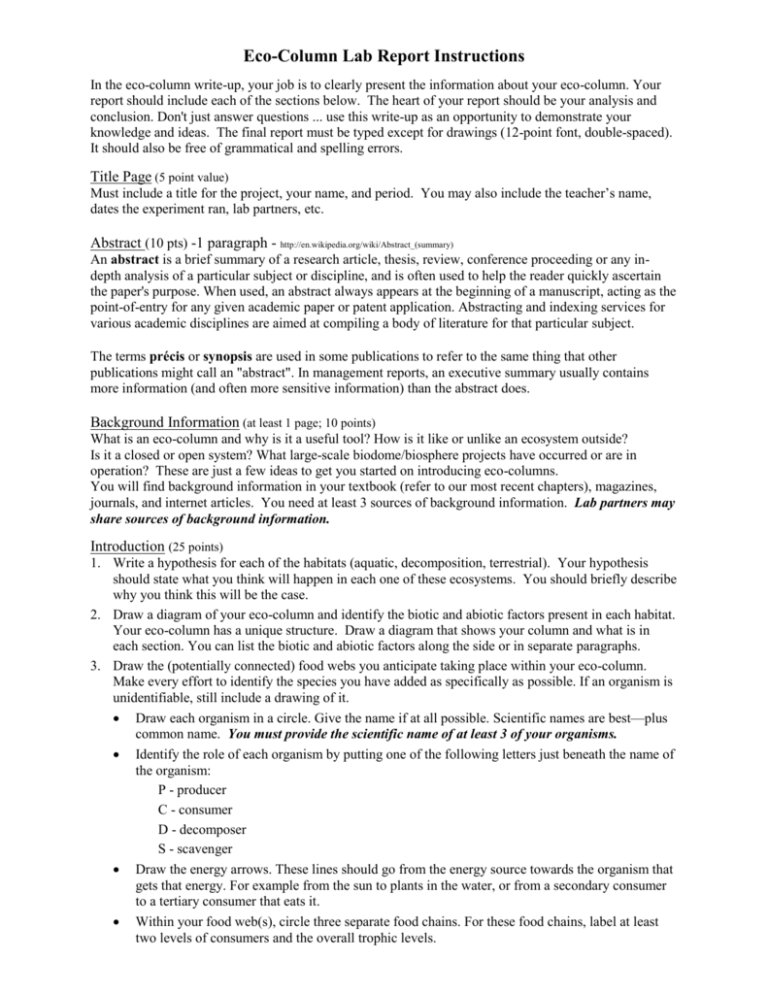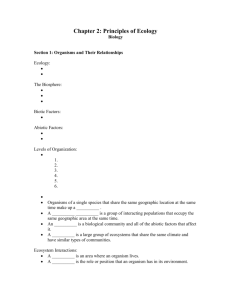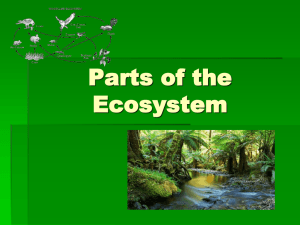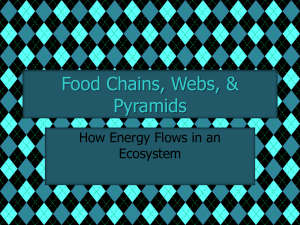Eco-Column Lab Report Instructions
advertisement

Eco-Column Lab Report Instructions In the eco-column write-up, your job is to clearly present the information about your eco-column. Your report should include each of the sections below. The heart of your report should be your analysis and conclusion. Don't just answer questions ... use this write-up as an opportunity to demonstrate your knowledge and ideas. The final report must be typed except for drawings (12-point font, double-spaced). It should also be free of grammatical and spelling errors. Title Page (5 point value) Must include a title for the project, your name, and period. You may also include the teacher’s name, dates the experiment ran, lab partners, etc. Abstract (10 pts) -1 paragraph - http://en.wikipedia.org/wiki/Abstract_(summary) An abstract is a brief summary of a research article, thesis, review, conference proceeding or any indepth analysis of a particular subject or discipline, and is often used to help the reader quickly ascertain the paper's purpose. When used, an abstract always appears at the beginning of a manuscript, acting as the point-of-entry for any given academic paper or patent application. Abstracting and indexing services for various academic disciplines are aimed at compiling a body of literature for that particular subject. The terms précis or synopsis are used in some publications to refer to the same thing that other publications might call an "abstract". In management reports, an executive summary usually contains more information (and often more sensitive information) than the abstract does. Background Information (at least 1 page; 10 points) What is an eco-column and why is it a useful tool? How is it like or unlike an ecosystem outside? Is it a closed or open system? What large-scale biodome/biosphere projects have occurred or are in operation? These are just a few ideas to get you started on introducing eco-columns. You will find background information in your textbook (refer to our most recent chapters), magazines, journals, and internet articles. You need at least 3 sources of background information. Lab partners may share sources of background information. Introduction (25 points) 1. Write a hypothesis for each of the habitats (aquatic, decomposition, terrestrial). Your hypothesis should state what you think will happen in each one of these ecosystems. You should briefly describe why you think this will be the case. 2. Draw a diagram of your eco-column and identify the biotic and abiotic factors present in each habitat. Your eco-column has a unique structure. Draw a diagram that shows your column and what is in each section. You can list the biotic and abiotic factors along the side or in separate paragraphs. 3. Draw the (potentially connected) food webs you anticipate taking place within your eco-column. Make every effort to identify the species you have added as specifically as possible. If an organism is unidentifiable, still include a drawing of it. Draw each organism in a circle. Give the name if at all possible. Scientific names are best—plus common name. You must provide the scientific name of at least 3 of your organisms. Identify the role of each organism by putting one of the following letters just beneath the name of the organism: P - producer C - consumer D - decomposer S - scavenger Draw the energy arrows. These lines should go from the energy source towards the organism that gets that energy. For example from the sun to plants in the water, or from a secondary consumer to a tertiary consumer that eats it. Within your food web(s), circle three separate food chains. For these food chains, label at least two levels of consumers and the overall trophic levels. Write a discussion of your food web. Within your discussion include the following: 1. What are the top level consumers in your eco-column? 2. What would happen to these consumers if all the primary consumers were to die? 3. If the secondary consumers in one of your food chains consumed 4,200 kcal, what amount of energy would you assume was available to the primary consumer? What amount would you speculate will be available to tertiary consumers? 4. What would happen if the decomposers were removed? 5. What do you think is more resilient (i.e. damage resistant), a food web with many species or a food web with just a few species? Explain your answer fully. If you can think of arguments on both sides, discuss both. Be sure to explain each of your responses to the above questions! Results (data) (10 points) Include table(s) and/or graph(s) with data to show significant changes within your eco-column. You will have to decide which data would be significant to show. (Try to pick data that will show change over time.) Include qualitative information from the disassembly of your eco-column (and the results from your soil test). Did you discover any unexpected organisms (for example: fungus grew or new microorganisms appeared)? Did you not see any new organisms? Be specific on where you looked and what you found. BIG HINT!!! A before and after table would be a useful way to present information like numbers of snails found, etc. Analysis (10 points) This part of the report explains your data and should be written in paragraph form. 1. Discuss the data for your eco-column with regard to your setup. What does your data say about what has gone on in your eco-column? Make sure you discuss the data collected during the weekly observations and the detailed soil and water measurements. 2. What conclusions or generalizations can you make about your eco-column and what connections can you make to other natural systems? 3. Diagram and explain the biogeochemical cycle as it occurred in your eco-column. Include the name and description of each of the parts of the nitrogen cycle covered in class. Conclusion (at least 2 pages; 20 points) This is the most important part of the report! Decide whether or not your data and observations supported your hypothesis. Then tell us what you learned through your research. Identify changes that occurred in your eco-column and why such changes occurred and their implication as far as the health of the ecosystem is concerned. Comment about the stability and sustainability of the various eco-columns in the classroom. Do some eco-columns appear to be more stable than others? Why is this so? Compare your artificial ecosystem to real ones outside the classroom. How are they similar? How are they different? Was your eco-column a closed system or an open system or something in-between and how does that affect it? How is the information that you gathered useful to the whole community? In what ways would it be useful to extend and expand this research? Sources of Error: Identify any weaknesses in your investigation. These could include equipment malfunctions, calculations or data collection errors, or simple human mistakes such as performing a test incorrectly. Sources of error could also include poor experimental design. Identify at least 3 sources of error and explain how each would have impacted your data. Bibliography (5 points) Must include at least 3 appropriate sources in APA format. See our class webpage for this. http://tyang-web.cuhsd.org/ Please printout and attach this rubric to your lab report. APES ECOCOLUMN LAB GRADING RUBRIC LAB REPORT SECTIONAL DESCRIPTIONS POINTS POINTS AVAILABLE EARNED TITLE 5 ABSTRACT 10 BACKGROUND INFORMATION 10 INTRODUCTION 25 RESULTS 10 ANALAYSIS 10 CONCLUSION 20 BIOLIOGRAPHY 5 OVERALL LAB FORMAT 5 POINTS EARNED 100











